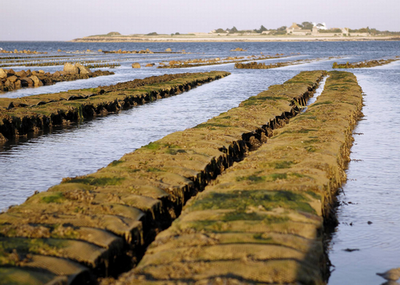
A mysterious ailment is killing up to 80 per cent of adult oysters in shell fisheries around the French coast this summer, threatening an industry already weakened by a succession of crises.
The bizarre weather – weeks of rain and cold followed by tropical temperatures – is officially blamed for the sudden death of scores of thousands of oysters in south-western France, Brittany and Normandy.
But producers fear that an unknown disease may be devastating oyster beds, stricken since 2008 by a virus which massacres baby oysters. French output has been slashed by a third in the past four years.
"Some people are having to ration their sales," said Olivier Laban, president of the association of oyster producers in the Bay of Arcachon, near Bordeaux. "We were already producing relatively few oysters because of the deaths of juveniles in past years. Prices are very high and cannot really go higher."
The sudden death of adult oysters, just before they go on sale, is even more calamitous. "It means three years of work wiped out overnight," said Laurent Champeau, president of the shellfish producers in the La Rochelle area. "Our margin for manoeuvre is already practically nothing."
The demise of 15 to 80 per cent of the two- to three-year-old oysters in Arcachon, Poitou-Charentes, northern Brittany and Normandy may be caused by the strange weather pattern this year, experts believe. Incessant rain from May to early July reduced the salt content of the water in the mud flats where the oysters are reared. The heat wave since mid-July has further weakened the shellfish, making them vulnerable to disease.
Tristan Renault, of the French maritime research agency, Ifremer, said that a deadly bacterium, Vibrio aesturianus, had been found in many dead oysters. "This was the murder weapon but we still need to find the assassin," he said. "The unusual weather [is] probably to blame."
Shellfish producers fear, however, that the weather masks a longer-term problem. They point out that there has been a gradual increase in the mortality of adult oysters in the past two or three years – reminiscent, they say, of the slow onset of the disease which began to kill off tiny oysters in 2008 and 2009.
The massacre of the oyster innocents – three quarters still die each year – has been traced to a form of herpes virus, OsHV-1. Its sudden attack on the French shellfisheries has been blamed on global warming or pollution of sea water, or both.
Oyster production in France has fallen from 120,000 tons four years ago to around 80,000 tons last year.
French officials and producers' groups are anxious to point out that there is nothing in these diseases which makes surviving oysters dangerous to human health. Oyster fisheries in Arcachon Bay, the biggest in Europe, have suffered a rash of temporary closures after human health scares in recent years, but these are said to have no link to the ailments attacking baby and adult oysters.
Mr Laban points out that the death toll of adult oysters is most acute in hatcheries. "Wild oysters are not affected at all but the death rate among oysters reared in hatcheries is huge," he said. "We also notice that the oysters born in the wild are stricken if they are brought into the bassins d'affinage [rearing enclosures close to the shore]."





